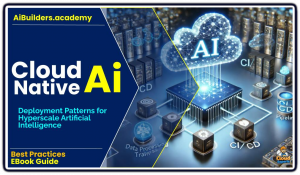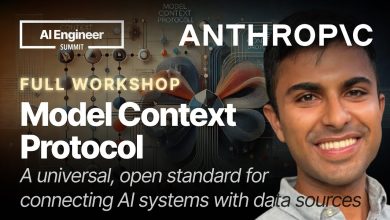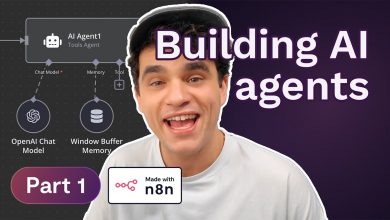Building Cloud-Native AI at Scale
Cloud-native AI refers to AI systems designed and deployed using cloud-native principles: microservices, containerization, orchestration, and continuous delivery.
 The convergence of AI and cloud-native architectures has transformed how organizations develop, deploy, and scale intelligent systems.
The convergence of AI and cloud-native architectures has transformed how organizations develop, deploy, and scale intelligent systems.
Cloud-native AI leverages the elasticity, resilience, and automation of cloud platforms to deliver AI solutions that are not only performant but also adaptable to dynamic workloads and global demands.
What is Cloud-Native AI?
Cloud-native AI refers to AI systems designed and deployed using cloud-native principles: microservices, containerization, orchestration, and continuous delivery.
Unlike traditional AI deployments that rely on monolithic architectures or on-premises hardware, cloud-native AI embraces distributed systems, leveraging the scalability and flexibility of cloud platforms like AWS, Azure, Google Cloud, and emerging players such as xAI’s infrastructure ecosystem.
The goal is to create AI solutions that are:
- Scalable: Capable of handling massive datasets and inference requests.
- Resilient: Fault-tolerant and self-healing in the face of failures.
- Portable: Agnostic to underlying infrastructure, deployable across hybrid and multi-cloud environments.
- Efficient: Optimized for cost, performance, and resource utilization.
Key Architectural Components
Building cloud-native AI at scale requires a well-defined architecture. Below are the core components:
1. Data Ingestion and Processing
AI thrives on data, and cloud-native systems excel at processing it at scale. Modern pipelines use:
- Event-driven frameworks: Tools like Apache Kafka or AWS Kinesis ingest real-time data streams from IoT devices, user interactions, or logs.
- Distributed storage: Data lakes (e.g., S3, Delta Lake) store structured and unstructured data, while databases like BigQuery or Snowflake handle analytics.
- Preprocessing: Serverless functions (e.g., AWS Lambda) or containerized workflows (e.g., Kubernetes jobs) clean and transform data before feeding it into models.
2. Model Training at Scale
Training large-scale AI models, such as transformers or diffusion models, demands significant compute power. Cloud-native approaches include:
- Distributed training: Frameworks like TensorFlow’s tf.distribute or PyTorch’s DistributedDataParallel leverage GPU/TPU clusters.
- Orchestration: Kubernetes with Kubeflow manages training workloads, scaling pods across nodes dynamically.
- Spot instances: Cost optimization using preemptible VMs on AWS or GCP reduces training expenses by 70-80%.
3. Model Deployment and Inference
Once trained, models must be deployed efficiently:
- Microservices: Each model is containerized (e.g., Docker) and exposed via REST or gRPC APIs.
- Serverless inference: Platforms like AWS SageMaker Serverless or Azure Functions handle sporadic workloads.
- Edge integration: Tools like KubeEdge or AWS Greengrass extend inference to IoT devices or edge nodes.
4. Monitoring and Observability
AI systems require continuous monitoring:
- Model performance: Track metrics like latency, accuracy drift, and bias using Prometheus or Grafana.
- Infrastructure health: Cloud-native tools like Istio or Linkerd monitor service mesh traffic.
- Logging: Centralized systems (e.g., ELK stack, CloudWatch) aggregate logs for debugging.
5. Automation and CI/CD
Cloud-native AI embraces DevOps practices:
- MLOps pipelines: Tools like MLflow, Argo Workflows, or GitHub Actions automate training, validation, and deployment.
- Infrastructure as Code (IaC): Terraform or Pulumi provision resources reproducibly.
- A/B testing: Canary deployments via Istio or Flagger roll out model updates incrementally.
Tools and Technologies
The cloud-native AI ecosystem is rich and evolving. Here’s a snapshot of key tools in 2025:
- Container Orchestration: Kubernetes remains the de facto standard, with enhancements like KEDA (Kubernetes Event-Driven Autoscaling) for AI workloads.
- AI Frameworks: PyTorch and TensorFlow dominate, with JAX gaining traction for high-performance research.
- Cloud Providers: AWS SageMaker, Google Vertex AI, and Azure Machine Learning offer end-to-end platforms, while xAI’s bespoke infrastructure targets frontier AI models.
- Observability: OpenTelemetry provides unified telemetry for AI and infrastructure metrics.
- Storage: Delta Lake and Apache Iceberg enable scalable, ACID-compliant data lakes.
Best Practices for Scaling Cloud-Native AI
- Design for Elasticity: Use auto-scaling groups or Kubernetes Horizontal Pod Autoscalers (HPA) to match compute resources to demand. For example, scale inference endpoints during peak traffic and scale down during lulls to optimize costs.
- Optimize Data Pipelines: Partition datasets across distributed file systems (e.g., HDFS, S3) and use lazy loading with libraries like Dask or Ray to minimize memory overhead. Implement data versioning with tools like DVC to ensure reproducibility.
- Leverage Spot and Preemptible Resources: Training jobs can tolerate interruptions. Use spot instances or GCP’s preemptible VMs, paired with checkpointing, to slash costs without sacrificing progress.
- Prioritize Model Efficiency: Techniques like quantization, pruning, and knowledge distillation reduce model size and inference latency. For instance, a 175B-parameter model can be distilled into a 13B-parameter version with minimal accuracy loss, deployable on smaller GPU instances.
- Embrace Multi-Cloud and Hybrid Strategies: Avoid vendor lock-in by using portable frameworks (e.g., Kubernetes, ONNX). Hybrid setups—training in the cloud and inferring on-premises or at the edge—balance cost and latency.
- Secure the Pipeline: Encrypt data in transit and at rest (e.g., TLS, AWS KMS). Use role-based access control (RBAC) in Kubernetes and model watermarking to protect intellectual property.
Challenges and Solutions
- Challenge 1: Cost Management – AI workloads can spiral into budget breakers. Solution: Implement cost monitoring with tools like AWS Cost Explorer or Kubecost, and set budget alerts.
- Challenge 2: Latency – Real-time applications (e.g., autonomous vehicles) demand low latency. Solution: Deploy models closer to users via CDNs (e.g., Cloudflare) or edge compute.
- Challenge 3: Model Drift – Accuracy degrades as data distributions shift. Solution: Automate retraining triggers based on drift detection (e.g., using Evidently AI).
The Future of Cloud-Native AI
By 2025, trends point to deeper integration of AI with cloud-native paradigms:
- AI-Native Clouds: Platforms like xAI’s offerings will optimize for AI-specific workloads, blending compute, storage, and networking seamlessly.
- Federated Learning: Distributed training across edge devices will rise, preserving privacy while scaling compute.
- Sustainable AI: Carbon-aware scheduling (e.g., Google’s Carbon-Intelligent Compute) will minimize environmental impact.
Conclusion
Building cloud-native AI at scale is a multidisciplinary endeavor, blending AI expertise with cloud engineering. By leveraging microservices, container orchestration, and modern MLOps, organizations can deploy intelligent systems that are robust, scalable, and cost-effective. As the field evolves, staying agile—adopting new tools and refining architectures—will be key to unlocking AI’s full potential in the cloud.



